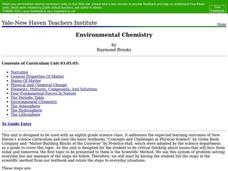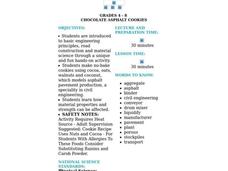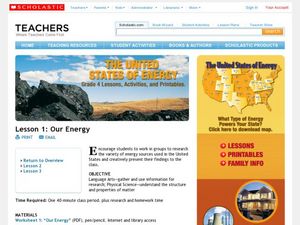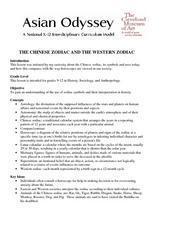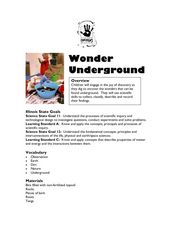Curated OER
Environmental Chemistry
Eighth graders are introduced to the topic of Environmental Chemistry. In groups, they review the steps within the scientific method and develop their own hypothesis and design an experiment. They solve equations related to the...
Curated OER
Crystals: What Are They and What Holds Them Together
Students are introduced to the characteristics of crystals and what keeps them together. Using the Periodic Table, they examine the various elements and develop a model of an atom. In groups, they place sugar and salt in petri dishes...
Curated OER
Revolution in Russia
As an overview of the Russian Revolution, this presentation provides a well-thought-out and comprehensive look at this subject. The outlines, questions, and other information provide a high-level look at WWI and the Russian Revolution....
Curated OER
Scientific Detectives
Learners examine the legitimacy of advertisers' claims about products using science and critical thinking. They view and discuss ads, read a case study, and conduct an experiment to demonstrate whether a product lives up to its claims.
University of Minnesota
The Ladder of Torture
The awful practice of torture is the focus of this sociology instructional activity. Students examine their own personal values regarding torture. They participate in a class discussion that considers the moral issues surrounding the use...
Curated OER
Math: Matching Rods and Religion
Math and religious studies are integrated together using using cuisenaire rods and Kid Pix for this problem-solving exercise. In pairs, they match different colored rods to represent various groups of people. Meanwhile, students at...
Curated OER
Tornadoes
Young scholars examine the characteristics of a tornado. They practice using new vocabulary and participate in a question and answer session. They use the internet to gather more specific information.
Curated OER
ADULT ESOL LESSON PLAN--Level 5--Consumer Education
Students focus on identifying the differences between automobile, property, and health insurances. They also review the different cost for each and view a variety of brochures. In addition, they chart their findings to visualize all...
Curated OER
Chocolate Asphalt Cookies
Students make no-bake cookies to learn basic engineering principles, road construction and material science. They experience properties and changes in matter.
Curated OER
Pack Your Bags: Explore South Carolina
Third graders investigate different counties in South Carolina. In this geography lesson, 3rd graders are assigned a county in South Carolina to research and identify important facts about the county. Students create a PowerPoint...
Curated OER
Our Energy
Fifth graders research energy sources used in the United States. In this energy sources lesson, 5th graders work in teams to research various energy sources. Students complete a worksheet for the research and make a short video of a...
Curated OER
Digital Scavenger Hunt
Students participate in a game of scavenger hunt. In this teamwork lesson, students use clues to find hidden objects. Students must work cooperatively to complete each task.
Curated OER
The Entrepreneur's Game
Twelfth graders explore the basic principles of the US free enterprise system. They examine the basic principles of the US free enterprise system including profit motive, voluntary exchange, private property rights, and competition.
Curated OER
the Wonder of Wetlands
Students explore the importance of the wetland ecosystem, its properties and functions, as well as, the many birds, animals, and plant life found there.
Curated OER
The Chinese Zodiac And The Western Zodiac
High schoolers create individual horoscopes that contrast and compare Western and
Chinese views of their futures using poster boards and magic markers. In-class discussion is used to evaluate the use of the Zodiac in different cultures.
Curated OER
Indi/Visual
Eighth graders take photographs for a photo essay contest. Using primary source documents, they review various types of artwork and discuss how some of the images have become commonplace. They use the internet to view examples of...
Curated OER
Plants in Your Gas Tank: From Photosynthesis to Ethanol
Explore ethanol and how it is produced. Young scientists investigate photosynthesis and fermentation to the concept of conservation of energy and mass. They discuss the environmental and economical benefits of ethanol as a fuel additive.
Curated OER
Wonder Underground
Young scholars classify and record objects they find "underground." For this observation lesson, students dig into bins filled with soil and encounter various objects such as bark, twigs, etc. Young scholars classify their findings.
Curated OER
One Plus One Makes You and Me - Respect
Young pupils should benefit from this wonderful series of activities designed to teach them how to get along with, and respect each other. Learners recognize how to demonstrate both respectful and disrespectful behavior, and take part in...
Curated OER
Oil Embargo!
Ninth graders generate and analyze data to determine which and how much of two polymers best absorb oils, formulate procedure to accurately determine how many times its own weight particular polymer can absorb, and develop understanding...
Curated OER
The Formation of Public Opinion: Ch 8
After reading about the formation of public opinion, the class can complete this quiz. They answer 5 true/false statements regarding public policy, political attitudes, and public opinion. Then they answer 5 multiple-choice questions...
Curated OER
Robert Boyle and the Mechanical Philosophy
Students read and discuss Boyle's Mechanical Philosophy and his rejection of Aristotle's theory of "Forms and Qualities." They answer a given set of questions and discuss these with the class.
Curated OER
Free Land
Learners investigate the impact of the passage of the Homestead Act. In this Westward Expansion instructional activity, students visit selected websites to examine the lives of Americans who settled the American frontier.
Curated OER
Sediment Tubes
Students observe how different density soils and rocks behave in wind and in water. They make predictions and careful observations as they explore sediment transport and sediment rates in streams and rivers.
